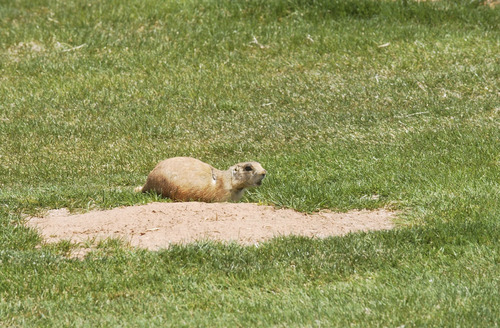This is an archived article that was published on sltrib.com in 2013, and information in the article may be outdated. It is provided only for personal research purposes and may not be reprinted.
State officials have agreed to sell 800 acres of school trust lands in Garfield County to manage as prairie dog habitat in an arrangement that will allow three rural airports to maintain or enlarge their runways even if it means killing the threatened rodents.
The complex deal brings together several state, federal and local agencies with a nonprofit in an effort to relieve restrictions developers face where private land and prairie dog habitat overlap in southwestern Utah.
In essence, the 800 acres act as a habitat credit of sorts, allowing the airports to eliminate the prairie dogs on or near its properties so the animals don't damage runways and create unsafe conditions for aviators.
"It's a great opportunity to improve the airport situation and safety issues and do good things for the prairie dog," said Laura Romin, deputy director of the U.S. Fish and Wildlife Service's Utah office.
The Utah School and Institutional Trust Lands Administration (SITLA) approved the transaction last month. The Federal Aviation Administration will supply the $800,000 needed to purchase the acreage at Johnson Bench, located on Paunsaugunt Plateau northwest of Bryce Canyon National Park, which will be transferred to The Nature Conservancy.
The Utah prairie dog, which was federally listed as endangered in 1973, is among five prairie dog species in the United States, though its protection status has since been downgraded to threatened. It is closely related to the white-tailed prairie dog, which inhabits eastern Utah and is not listed.
FWS, the agency coordinating prairie dog recovery, identified Johnson Bench for the deal because of its proximity to areas in Bryce and Dixie National Forest that are being carefully managed for prairie dog recovery, according to Romin.
"It's a central part of the populations around the park so it allows us to maintain connectivity to the populations out there," Romin said. A small colony inhabits the Johnson Bench acreage, which will likely be thinned and dusted with a pesticide that kills disease-carrying fleas. Plague, along with habitat loss, is a key threat to prairie dog recovery.
The Nature Conservancy's participation was key because the FWS cannot own land outside wildlife refuges and, as a private property owner, the conservancy will pay taxes on the land.
The airports benefiting from the deal are located in Cedar City, Loa and Parowan, where officials have been struggling for years to maintain runways without harming the protected prairie dogs.
"The mitigation monies paid by the FAA and the local communities have now provided these airports the ability to secure their safety for the future, as well as at present. SITLA has been a great partner in helping provide a solution to this long standing problem," Iron County Commissioner Alma Adams said.
When the transaction is consummated later this year, the money will be deposited in the state's Permanent School Fund.



